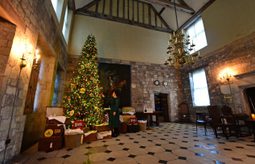About York
York is one of England’s finest and most beautiful historic cities. Halfway between London and Edinburgh, York is situated in northern England within the county of Yorkshire. With Roman roots and a Viking past, York offers an eclectic mix of culture and history – with hidden gems and unique experiences around every corner.
The Romans knew it as Eboracum, to the Saxons it was Eoforwick and the Vikings – who came as invaders but stayed on in settlements – called it Jorvik. The York of today is a fashionable city that successfully combines its heritage and superb historic architecture with independent shops, restaurants, bars and cafés, to attract tourists from all over the world.
Crowned Britain’s Home of Chocolate, the most haunted city in Europe and with one of the best racecourses in the country, York is abundant with culture and character. Plus, the city’s thriving cultural and creative sector has seen it become the UK’s first and only UNESCO Creative City of Media Arts, with creativity embedded in every aspect of the city.
New to the city?
Here are our recommendations for the top things to do in York!
Enjoy our curated list of the top must see and do in York, combining history with modern culture. Perfect for history buffs, the city and outer areas boasts stunning architcture and attractions that go back centuries. Whether you're here for the day or you're able to stay for a longer period, there's plenty of exciting things to do and see in York.
- York City Walls – Originally built by the Romans and expanded by medieval rulers, these walls have protected York for nearly 2,000 years and still trace the shape of the ancient city.
- JORVIK Viking Centre – Set on the site of actual Viking-age discoveries, the JORVIK Viking Centre allows a full immersive experience of the sights, sounds, and smells of the time.
- York Minster – This magnificent cathedral has stood as a centre of Christian worship for over 800 years, its medieval stained glass windows telling stories of faith and history.
- Explore Snickelways – These twisting alleys follow paths worn by medieval townsfolk, connecting traders’ homes, markets and churches. Now, discover the hidden gems residing on these streets such as unique shops, restaurants, and cosy pubs.
- Chocolate Trail – York’s sweet legacy began with 19th-century chocolatiers like Rowntree and Terry, whose innovations shaped both the city and Britain’s confectionery industry.

- National Railway Museum – York’s status as a railway hub dates back to the 19th century, when steam transformed travel and industry across the nation.
- River Ouse Cruise – The River Ouse has been York’s lifeline since Roman times, carrying goods, traders and stories that built the city’s wealth and character.
- Ghost Walks – York’s long and sometimes turbulent past – from Viking raids to civil war – has given rise to centuries of ghostly tales and folklore.
- Clifford’s Tower & Minster Views – From Norman conquests to royal sieges, these heights have witnessed York’s most dramatic chapters and now offer panoramic views of York's skyline.
- Dining in York – Today’s thriving food scene continues a tradition of hospitality that dates back to York’s medieval markets, where merchants and travellers gathered to share a good meal.

About York's History
"The History of York is the history of England." King George VI
Both ancient and modern history has made York the incredible city it is today. There’s the iconic York Minster and architecture from medieval times, its magnificent Georgian town houses and its Victorian railway station. As you explore York you will discover that every aspect of York’s modern life is inextricably linked with its past. Within its ancient, encircling walls, York’s medieval streets and buildings are beautifully preserved in the historic heart of the city. Shambles is a must-visit, as one of the most recognised historic streets in England, often referred to as the best-preserved medieval street in Europe. Discover more about the history of Shambles Market here.
Roman History
While archaeological evidence suggests that settlements around York date back to the Mesolithic period, the city as we now know it began with the Romans in 71 AD, when 5000 men from the ninth legion marched from Lincoln to set up camp and conquer York. Not only did the Romans create York, they lived and ruled in it for the next three centuries, turning it into a city of global importance.
Only 2% of Roman remains have been rediscovered in York, so some of Roman city still remains a secret. The longest stretch of surviving Roman Fortress wall is in the Museum Gardens, including the Multangular Tower. Although the Roman Empire eventually faded, their legacy lives on; the armies of ancient Rome will march on York again this summer at the Eboracum Roman Festival. Plus, discover the remains of York’s Roman bathhouse on St Sampson’s Square, and explore The Yorkshire Museum - the home to some of Britain’s most significant Roman treasures.
Viking History
The Viking invasion of York took place on November 1st 866AD and was led by Ivar The Boneless who along with King Halfden renamed the city Jorvik. The Vikings who settled in York farmed the land and were great craftsmen, traders, artists, engineers and ship builders. Over the one hundred years that York was under Viking rule the city prospered greatly. Today the Viking heritage is still celebrated in the city, through the Scandinavian name for a road, ‘Gata’, which appears in street names such as Stonegate to Petergate to Coppergate.
The world-famous JORVIK Viking Centre takes visitors on an unforgettable journey back in time to relive everyday Viking life. Viking history is even evident through the family-friendly business Little Vikings who offer recommendations for families in the city. We can certainly thank the Vikings in part for the beautiful legacy they have left in the city.
Medieval History
The Medieval period is an important era in York’s history, as many of the city’s landmark buildings that make up the city skyline were built within this era. The city walls were rebuilt and strengthened, and old wooden Viking buildings were reconstructed in stone. Four new fortified gates, or "bars", were built to regulate traffic through the walls and the stone keep of York Castle (today known as Clifford’s Tower) was reinforced.
The city’s growing prosperity in trade and commerce is reflected in the imposing Merchant Adventurers' Hall and the Guildhall. Learn more about the medieval history of the city at the Yorkshire Museum’s display showcasing their permanent collection of the region’s greatest surviving treasures. The exhibition ‘Medieval York: Capital of the North’ explores how York became England’s second city and how its fortunes rose and fell with its ties to the Crown and the Church.
FAQs About the History of York
Q: What is the history of York in a nutshell?
A: York has over 2,000 years of history, beginning with the Romans in 71 AD. It later became a thriving Viking city called Jorvik, grew into a powerful medieval centre, and continued to flourish through the Georgian and Victorian eras. Today, its heritage shapes everything from its architecture to its culture.
Q: Why is York considered one of England’s most historic cities?
A: Few cities have such a complete timeline of British history in one place. York has Roman ruins, Viking discoveries, medieval streets, Georgian townhouses and a Victorian railway station, all preserved within ancient city walls.
Q: What was York originally called?
A: The Romans named it Eboracum, the Saxons called it Eoforwick, and the Vikings renamed it Jorvik. Over time, these names evolved into the modern “York”.
Q: What Roman history can I see in York today?
A: Visitors can explore the Multangular Tower in Museum Gardens, part of the original Roman fortress wall. You can also see Roman objects at the Yorkshire Museum and visit the remains of a Roman bathhouse near St Sampson’s Square.
Q: How important was York during Viking times?
A: Under Viking rule from 866 AD, York became a major trading hub known as Jorvik. The Vikings shaped the city’s streets, crafts and culture, which you can discover today at the JORVIK Viking Centre.
Q: What medieval history is York known for?
A: Many of York’s most iconic landmarks date from the medieval period, including the city walls, Clifford’s Tower and York Minster. Streets such as the Shambles still follow their medieval layout and are among the best-preserved in Europe.
Q: Why is the Shambles famous?
A: The Shambles is often described as Europe’s best-preserved medieval street. Its timber-framed buildings and narrow layout show what York looked like centuries ago, and it remains one of the city’s most recognisable locations.
Q: What role did York play in later centuries?
A: York continued to grow in the Georgian era, becoming known for its elegant townhouses and civic buildings. In Victorian times it became a major railway hub, a story told today at the National Railway Museum.
Q: What are some surprising facts about York’s past?
A: York is known as Britain’s “Home of Chocolate”, Europe’s most haunted city, and the UK’s first UNESCO Creative City of Media Arts. Its long history spans Roman soldiers, Viking settlers, medieval merchants and modern innovators.
Q: How does York’s history influence the city today?
A: Much of York’s modern life takes place within its historic walls. Its streets, festivals, attractions and even place names still reflect centuries of cultural layers.








